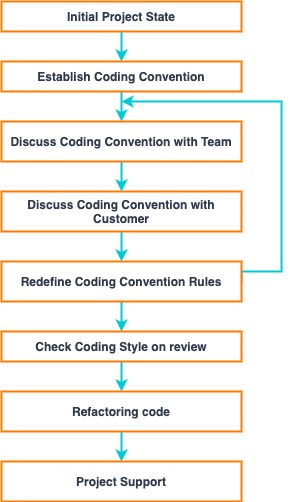The quality of code development has several aspects, so adhering to certain rules when writing code is important. This applies not only to formatting but also to many other factors, determined by the corresponding coding convention for the selected programming language and the selected development framework.
The importance of adhering to a coding convention, as well as a unified style of writing code, and following certain rules when building an architecture, is hard to overestimate.
These are important points in the development of code, and in many ways, they are the key to the success of the product in the future.
Let's see why, where, and when to use the coding conventions.
Table of contents:
- What is Coding Conventions.
- Why use coding Conventions.
- Where and When to use Coding Conventions.
- Software development coding standards.
- Conclusion.
What is Coding Conventions
The code formatting standard is generally accepted and used by a group of software developers to uniformly share code. The purpose of adoption and use of the standard is to simplify the understanding of program code by a person, and minimize the load on memory, thinking, and vision when reading a program.
An example of a coding standard is a set of conventions adopted in any common printed work in a language (for example, the C standard for coding, which received the acronym K&R, comes from the classical books of C by Kernighan and Ritchie). Another example is a widely used library or API (for example, the distribution of the Hungarian notation was clearly influenced by its use in the Windows API, and most coding standards for Python use, to one degree or another, the PEP standards).
Language developers also release detailed coding guidelines. For example, Microsoft’s C # coding standards and Oracle’s Java coding standards have been released. The coding manner proposed by the developer or accepted by well-known sources is more or less supplemented and refined in corporate standards.
Typically, a coding convention standard describes:
- ways of choosing names and the used case of characters for variable names and other identifiers:
- writing the type of the variable in its identifier (Hungarian notation) and a cast of characters (lower, upper, "camel", "camel" with a lowercase letter), the use of underscores to separate words;
- indentation style for logical blocks - whether tabs are used, indent width;
- a method for placing brackets bounding logical blocks;
- the use of spaces in the design of logical and arithmetic expressions;
- comment style and the use of documentary comments;
- variable, class and file naming conventions;
- statement style and best practices of their usage;
- file organization;
- declaration of classes and interfaces;
- programming practices.
Outside of the standard, the following are implied:
- lack of magic numbers;
- restriction of the size of the code horizontally (so that it fits on the screen) and vertical (so that all the code of the file is held in memory)
- as well as a function or method to the size of one screen (for some programming languages).
Coding rules are “must have” in modern software development. This means that it is better to write programming code a little bit slower than usual, but according to all requirements from the coding conventions. Then you will write code in the style of required coding conventions and the process will be done at the same speed. But the quality of code will be much much better.
Why use coding Conventions
Why are coding standards important? Let's take a look from a different point of view and take into account the results of using coding conventions. Coding standards are important for software developers for several reasons:
- 40% - 80% of the total cost of software is spent on its maintenance.
- Software is almost never fully supported by its original author.
- Coding standards improve software readability by allowing developers to understand new code faster and better.
- Like any other product, the software must be "well packaged" and clean.
As the developers of Svitla Systems note, “The project should be written in the same style. This is necessary both to improve support and speed up involving new developers and to prevent the writing of new bicycles or the use of unnecessary patterns in the project, where it is not needed at the moment."
In our experience, convention in software development improves code readability, facilitates the introduction of new developers on the project, and simplifies code writing, because there is an understanding of in what style it should be written, and therefore less refactor later (if standards are well written with architecture and structure).
The main reasons for using the coding convention are as follows:
- The same rules for writing code make it easy for other colleagues to understand
- It is easier to understand the code in a year or 5 without the need to read each term
- You always know where certain classes and files are in a huge project
In general, this is the cleanness of the code, which simply speeds up the work. This can be compared to a desktop: if everything is neatly arranged, it is easy to work. If there is a mess, then every little thing takes a long time to find.
Very often Coding Conventions for each team are different, and sometimes very different from project to project. We need them so that other developers can easily figure out the code and in general, the code written by different team members looks the same within the project and is maintainable and supportable.
For various programming languages, there are coding conventions. These coding conventions are not absolute. In each project and in each company, standards can be developed for the coding convention. Here is a chart for example:
| Programming Language | Coding Convention |
| C | GNOME C Coding Style |
| C++ | Google C++ Style Guide |
| C# | Microsoft C# Coding Conventions |
| Go | Code formatting and naming convention tools in Golang |
| Java | Oracle Java Code Conventions |
| Javascript | Google Javascript Style Guide |
| Python | PEP8 |
| PHP | PSR-2 |
| Ruby | Clearwater Ruby Coding Guidelin |
| Scala | Scala Style Guide |
| Swift | Google Swift Style Guide |
Where and When to use Coding Conventions
It is worth noting that coding convention is not just formatting. It is coding guidelines that all team members must follow.
Answering the question of when to use the coding convention, the easiest option is when writing the code itself. This provides for familiarization of all project participants with the convention and coordination of all necessary requirements.

Convention coding must be applied both by a single developer and by a development team.
Regardless of the qualifications of the developers, they must use the coding convention; this makes the software development process more stable and the code turns out to be better.
Note that during the Software peer review, compliance with the coding convention is very important.
The verification process of the coding convention can also be carried out during refactoring. This improves code readability and makes the whole project more unified.
Software development coding standards
What are coding standards? This is a set of documents and established processes for creating code and corresponding documentation. Standardization of coding conventions can be adopted at the following levels:
- Project level
- Company-level
- Developer Community Level
- Industry Standard Level
- ISO Level
Each programming language has some specifics to be applied to coding standards. It became in practice many years ago, for instance, ANSI C was introduced in 1983 by ANSI committee, X3J11 to standardize the C language. Then it was updated as ISO standard C89, C90, C95, C99, C11, C17, C2x. It means that coding standards are updated in parallel with the improvement of the programming language.
The importance of coding standards is proven by many generations of software developers. It is great to open some legacy code and understand the high level of effort that was done to make great and well-coded software according to the standards.
Conclusion
Our developers from Svitla Systems work according to conventions established and agreed upon with customers.
This applies to various programming languages and various frameworks. Coding standards in software engineering are taken seriously into consideration by all architects, developers and testers in Svitla Systems. It is very important to understand and have the necessary qualifications to identify the areas where coding standards are used.
Svitla Systems project managers and developers usually work with the following codebase options:
- fully fit into the customer development environment and integrate into the team, accepting the coding convention as a whole
- if the customer has not chosen a coding convention, our developers will always advise the best coding convention for this project
- if required, our developers can make changes to a certain coding convention and accept it for development
- if required (in very rare cases), our developers can write the necessary coding convention for the selected project, and follow it to conduct the project
Svitla Systems follows a high code development culture. This applies to strict adherence to the coding convention, as well as building a clear project architecture, developing unit tests, and adhering to agile (scrum) methodologies.
We always do the code correctly so that it can be supported in the future, is easy to understand and it is easy to complement the team with new developers.
The Svitla Systems company can also revise an existing project according to the coding convention; we know how to go through the process of unification and standardization of the code for the desired programming language and selected framework.





![[Blog cover] SEO optimization best practices](https://svitla.com/wp-content/uploads/2025/05/Blog-cover-SEO-optimization-best-practices-560x310.jpg)